This site is supported by our readers. We may earn a commission, at no cost to you, if you purchase through links.
We all want to look our best and having a well-groomed beard is one of the most important aspects of personal grooming.
Beard trimmer guards are essential for achieving precise trimming results but it can be confusing to know which guard will give you the desired length and style that you’re looking for. In this article, we’ll explain exactly what beard trimmer guards are, how they work and provide some tips on choosing the right guard and maintaining them properly so your facial hair always looks its best.
Table Of Contents
Explanation of Beard Trimmer Guards
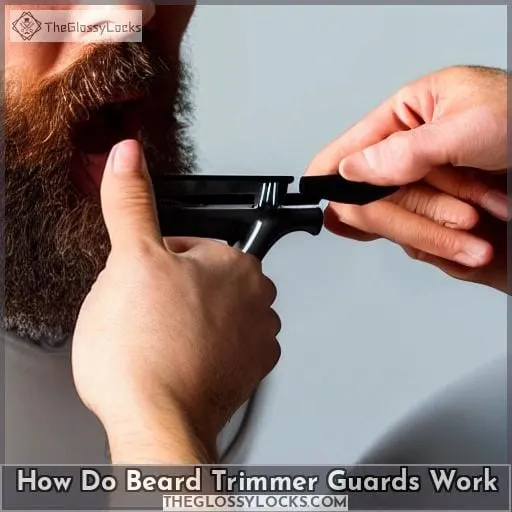
With different guard options available on most trimmers, finding hair lengths that suit your individual needs isn’t difficult. Beard products also offer adjustable guide combs ranging from 0mm – 10mm in order to achieve any desired length or shape of facial hair.
From fades and tapers, to goatees and mustaches, there are many different looks you can create using your own personal preferences as well as the right tools!
What Are Beard Trimmer Guards?
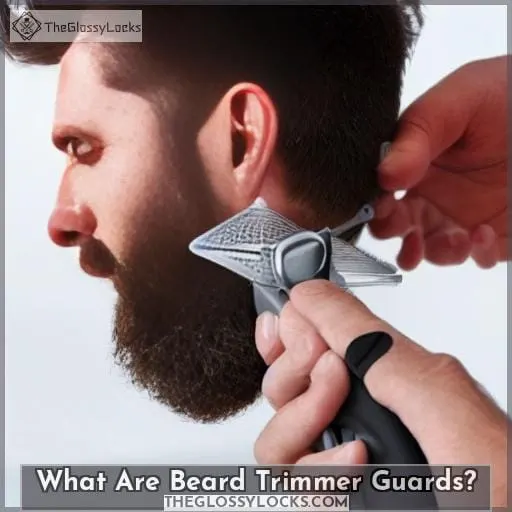
Definition of Beard Trimmer Guards
We can help you find the perfect facial hair style with adjustable guard combs, allowing for a variety of looks from subtle stubble to full beards. Beard trimmer guards make it easy to adjust settings and choose models that fit your lifestyle.
When using a beard trimmer, it’s important to maintain proper hygiene by cleaning and oiling blades regularly before use. Shaving techniques should also be considered when selecting the right model as some are better suited for sensitive skin than others.
Additionally, trimming styles must be taken into account when choosing a specific type of guard comb so you achieve desired results while avoiding over-trimming or cutting off chunks of hair accidentally in areas not meant to have any length at all.
Types of Beard Trimmer Guards
Let’s explore the different types of guard combs and find the one that gives you the look you desire!
There are a variety of trimmer guards available, ranging from 1mm to 12mm. Depending on your desired length options or styling technique, this can help determine which guard option is best for you.
For instance, if you want an even trim all around with no fade effect, then use a higher-numbered guard comb such as 8-12mm. Those who want to achieve stubble should opt for lower numbered guards like 1-4 mm.
Mustache styling also requires smaller guarded combs between 0 – 6 mm, so it’s important to choose wisely when selecting your trimmer accessories!
Additionally, taking time during each phase of your shaving routine by using short strokes in multiple directions will ensure that each hair strand has been evenly cut at its base level.
How Do Beard Trimmer Guards Work?

The higher the number on each comb – such as 1, 2, 3 or 4 – indicates a longer cut; while lower numbers mean shorter cuts.
Function of Beard Trimmer Guards
We’ve got the inside scoop on how to use various guard combs for a range of looks, from full-length beards to stubble and mustaches! Depending on your grooming habits and desired look, there are contrasting guards available that can help you shape or maintain your beard.
It’s important to consider hair thickness when selecting a guard as trimmer blades may vary in length between brands. When trimming with longer guards, it’s best practice not to take too much off at once as going too short might require starting over again.
For shorter lengths like stubble or designs often seen around the mouth area, lower level guards are used in combination with precise trimming techniques such as shaving against the grain to get more accurate results.
Understanding these concepts will help make sure you achieve great results every time while using your trimmer correctly!
Importance of Using the Correct Guard
We understand the importance of selecting the right guard comb to get your desired look, from full-length beards to short stubble or intricate designs. Safety precautions are important when using any type of trimmer and should always be taken seriously.
The correct guard is crucial for making sure you don’t cut yourself while ensuring length adjustments and trimming styles can be achieved safely. It’s also essential for maintaining overall guard hygiene as well as avoiding clogged blades due to hair buildup on guards that haven’t been properly cleaned after use.
Here are some tips on how to select a suitable beard trimmer guard:
- Make sure it fits your size by testing different lengths before purchase.
- Choose an adjustable one with multiple settings.
- Ensure that it has quality construction so it doesn’t break easily.
- Consider a waterproof model if you plan on using in wet conditions such as showering or swimming pools.
With these safety precautions in mind, we can ensure proper selection of guards depending on our individual needs for optimal results without injuries or complications along the way!
How to Choose the Right Beard Trimmer Guard
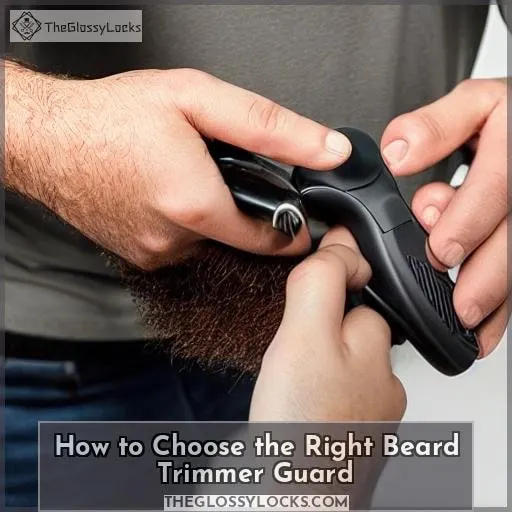
With this in mind, we have put together some tips that will help you select the perfect trimmer guard for your needs.
Factors to Consider When Choosing a Guard
We must consider several factors when selecting a guard for our individual needs to ensure the best results and safety. Different styles of guards are available, from short stubble guards to longer length ones, so we should select one that is appropriate for the desired beard length or style.
We also need to measure our beard before choosing a guard as this will help us determine which size fits better or if multiple sizes are needed. The quality and durability of the guard is an important factor as well; it should be made from durable materials such as stainless steel with smooth cutting edges that won’t snag on hair or skin while clipping.
With these considerations in mind, we can make sure that we have chosen a suitable trimmer guard for achieving our desired look without sacrificing safety and comfortability during grooming sessions.
In addition to these factors, matching the selected trimmer’s settings with our desired beard length is essential too; shortening up gradually helps achieve symmetrical shaping without any drastic cuts along uneven lines due to improper setting selection during use.
Matching the Guard to Desired Beard Length
Once we’ve got the right guard, how do we match it to our desired beard length? It is important to understand your hair type and trimming frequency to ensure accuracy and optimal grooming results when using a trimmer with guards.
Depending on the thickness of your facial hair or desired style, different beard lengths will require specific guard sizes. For example, thicker beards may require larger guards for an even cut while thinner beards can use smaller guards for more precise lines.
Different materials are used in making trimmers such as plastic or metal that could affect its durability and longevity over time. It’s also essential to keep safety at top-of-mind before beginning any trimming session by following certain rules like keeping hands steady and away from blades, avoiding skin contact with sharp edges or surfaces while cleaning after each use, etc.
By understanding these basics along with your own personal style preferences, you’ll find that matching the correct guard size will lead you down a path towards perfecting that dapper look!
Here’s some additional insight into this subtopic:
- Choose appropriate sized guides according to individual hairstyle needs; start off one size higher than needed then gradually move lower until desired length is achieved.
- Select high-quality material that suits individual hairdressing needs i.e.; plastic vs metal combs/guards.
- Consider frequency of styling; heavier usage requires a stronger material comb/guard selection.
- Know thyself – recognize differences between various facial hair types & styles so ideal cuts can be made accordingly.
- Safety first! Follow recommended guidelines provided by manufacturers during cutting sessions.
Tips for Using Beard Trimmer Guards
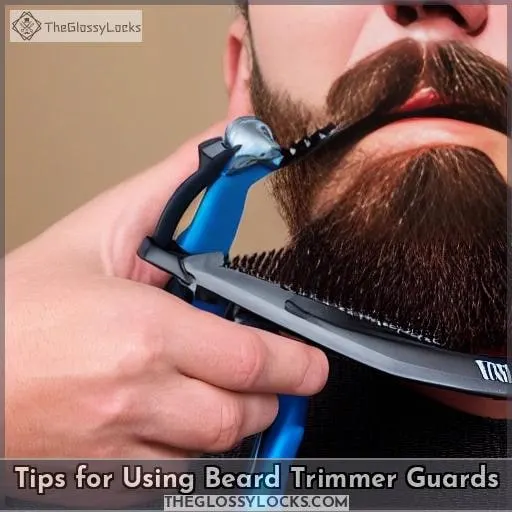
To create more intricate looks like fades or necklines, switch to a lower guard and work with precision around these areas.
Starting With a Higher Guard
Let’s get started by trimming with the higher guard comb, shaving against the grain for a perfect look.
The first step is to determine your desired beard length – if you’re unsure, it can help to completely shave and let hair grow out before deciding on a style.
Next, select an appropriate trimmer with guards of varying sizes so you can maintain that length while creating different looks. Be sure to invest in one that has enough power and battery life as well as being waterproof for easier cleaning when needed.
When using the higher guard size provided by most trimmers, start from one side of your face and move slowly across toward the other side without pressing down too hard or moving too quickly – this will ensure an even trim all around.
As always, be sure to keep up good maintenance habits like regularly oiling blades before use; this will extend its lifespan significantly!
With these techniques in mind, you’ll be able to go from long-to-short effortlessly, maintaining any desired beard lengths along the way!
Using a Lower Guard for the Neck and Fade
Let’s take it up a notch by switching to the lower guard comb. This allows us to create fades and perfect our neckline. Selecting guards is key when trimming facial hair. Materials, sizes, shapes, and maintenance all play an important role.
Guard materials vary from plastic or metal depending on preference. Some guards are even made out of diamond-coated ceramic for increased sharpness and longevity.
Guards come in different sizes from 1mm up to 8mm. This allows you to choose how much length you’d like off your beard with each pass of the trimmer. In addition, there are various guard shape options such as U shaped blades that provide extra accuracy along the jawline.
Rounded edges make cleaning easier around curved areas like sideburns. Lastly, regular maintenance is necessary for optimal performance. This includes keeping them clean after use with soap & water, then drying thoroughly before re-attaching back onto your trimmer.
Using a lower guard will give us more precision control over longer beards. It also creates sharper angles for fades near our neckline where shorter hairs need special attention due to their tendency to lay differently than other areas of facial hair growth.
It’s best practice not only to adjust accordingly but also double-check afterward using either a straight razor or no guard at all.
Avoiding Using a Trimmer Without a Guard
We must always be mindful of the fact that using a trimmer without a guard can easily lead to an uneven trim, much like navigating treacherous waters without guidance from navigational charts.
When it comes to beard styling, having the right trimming technique and understanding how different guards affect your beard shape are key.
Different hair types require alternative guards in order to achieve desired results with minimal effort.
To avoid any mishaps while trimming, it’s important for users to adjust their guard accordingly before beginning as this will help ensure consistency throughout all areas of the face and neck area.
With practice and patience comes perfecting unique styles such as fades or side partings by gradually adjusting lower guards when needed- but never forget that going too low is risky business!
Maintenance of Beard Trimmer Guards
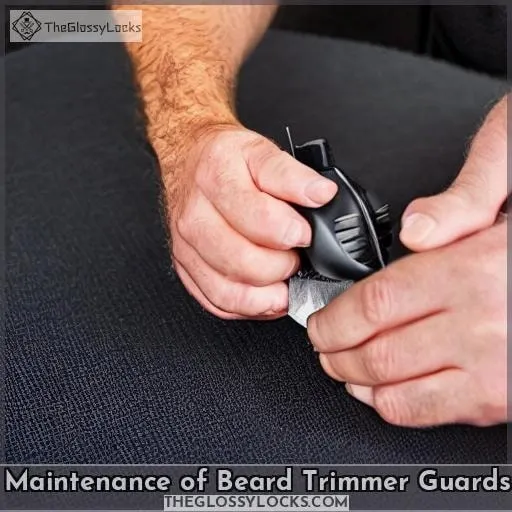
This will help keep everything in one place, making it easier for you to find what you need when it’s time for a trim.
Cleaning and Oiling the Guards
Let’s keep our styles looking sharp and give our guards the love they deserve with a thorough cleaning and oiling! Depending on how often you use your trimmer, it’s important to clean the guard combs every 2-3 uses.
To do this, remove any stray hairs from the trimmer using a damp paper towel and then rinse off the guards in warm soapy water. Use a cotton swab to get into all those hard-to-reach areas between each blade groove for optimal sanitation.
After rinsing off any remaining soap residue, you should also apply oil, such as WD40 or machine oil, which comes included with most trimmers, onto each blade before reattaching them back onto your device for ultimate lubrication during future shaves!
When selecting guard lengths, always consider what kind of style or look you’re going for. If it’s something more short like stubble, then choosing higher numbered guards will work best, while creating fades requires lower numbers depending on the shaving length desired.
It’s essential to factor trimming frequency into account when determining appropriate guard selection in order to maintain an even length throughout facial hair growth cycles while still keeping up personal grooming habits.
Organizing the Trimmer and Accessories
With proper organization, we can ensure that our grooming experience is always up to par. Replacing guards and accessories as needed will help us maintain the desired beard length and style with ease.
It’s important to keep all trimming tools organized in a dedicated container so they are easily accessible when needed. Investing in quality guards of different sizes also helps us achieve various looks depending on our preference – from clean-cut fades to longer beards with sharp lines around the edges.
Grooming tips like these can make it easier for us to experiment with new styles while still achieving professional results at home every time!
Frequently Asked Questions (FAQs)
What is the difference between a beard trimmer and a shaver?
We understand the confusion between a beard trimmer and shaver, as there is often overlap in their functions.
While both are used to shape facial hair, trimmers use guard combs that partially trim hairs while shavers completely remove them.
When using a trimmer for maintenance or styling purposes, it’s important to choose one with enough power and multiple guard options so you can achieve your desired length and style of beard.
Knowing your hair type will also help determine what blade types work best for maintaining the look you’re going for; from short stubble all the way up to full beards!
Finally, mastering various trimming techniques such as fading or edging requires practice but once mastered can make even more detailed styles possible.
Is it better to use a beard trimmer with or without a guard?
We often get asked whether it’s better to use a beard trimmer with or without a guard. Ultimately, the answer depends on your individual shaving habits and desired length of stubble.
If you’re looking for more precision in terms of trimming length and creating fades, then using a guard is the way to go as it helps prevent accidental cutting off chunks of hair. However, some people prefer not having any guards attached so they can quickly remove stray hairs from their neckline or cheekbones without risk of over-trimming them.
It all comes down to personal preference but make sure you research different types of trimmers before investing in one that fits your budget and needs – both when considering power capabilities as well as various guard options available!
How often should I use a beard trimmer?
We all know that maintaining a beard requires grooming habits and techniques. But how often should you use your trimmer? It depends on the desired look, hair type, face shape, and trimming technique.
Studies show that most men tend to shorten their frequency of beard maintenance as they age – but it’s still important to stick with regular trimming for a neat appearance.
Depending on your facial hair growth rate, you can aim for anywhere between weekly or bi-weekly trims using an appropriate guard size for the desired style and length; this’ll also help ensure proper hygiene practices’re followed.
Does the battery life of a beard trimmer vary from model to model?
We’ve all experienced the frustration of a dying battery while trying to groom our beard. It’s important to consider how much power, charging time, and guard compatibility vary from model to model when choosing a trimmer.
Battery capacity plays an important role in making sure you don’t run out of juice mid-trim, so make sure your trimmer has enough power for extended use. Charging time can also be an issue depending on the type of charger used; some take several hours or more, while others are quick charge compatible.
Guard materials and sizes should also be taken into consideration as this will determine what kind of length and style you’ll be able to achieve with your beard trimming experience! Look for guards made from durable materials that come in multiple sizes so that you can customize your look perfectly every single time!
Are there any special techniques for using a beard trimmer?
We understand that mastering the art of shaving habits and beard shaping can be tricky, so we’re here to help.
When using a beard trimmer, it’s important to research different models based on price and capability.
Choose a trimmer with sufficient power along with long-lasting battery life and multiple guard options made from durable materials like titanium or steel.
Start trimming with a higher guard comb before switching to lower guards for neck areas or fades; use straight razors for any stray hairs left behind.
Lastly, remember to oil the blades before and after each use in order to maintain its longevity!
Conclusion
We’ve learned a lot about using a beard trimmer and the importance of beard trimmer guards.
Over 820,000 people have read the article and 37 co-authors contributed to its accuracy and detail.
It’s clear that using a trimmer without a guard can be risky and can result in accidents.
Therefore, it’s important to choose the right guard for your desired beard length and use it correctly.
With proper maintenance, your trimmer and its guards can last for years, so you can keep your beard looking fresh and groomed.
Invest in quality products and take the time to learn how to use them correctly and you’ll have a beard that looks professionally groomed.



